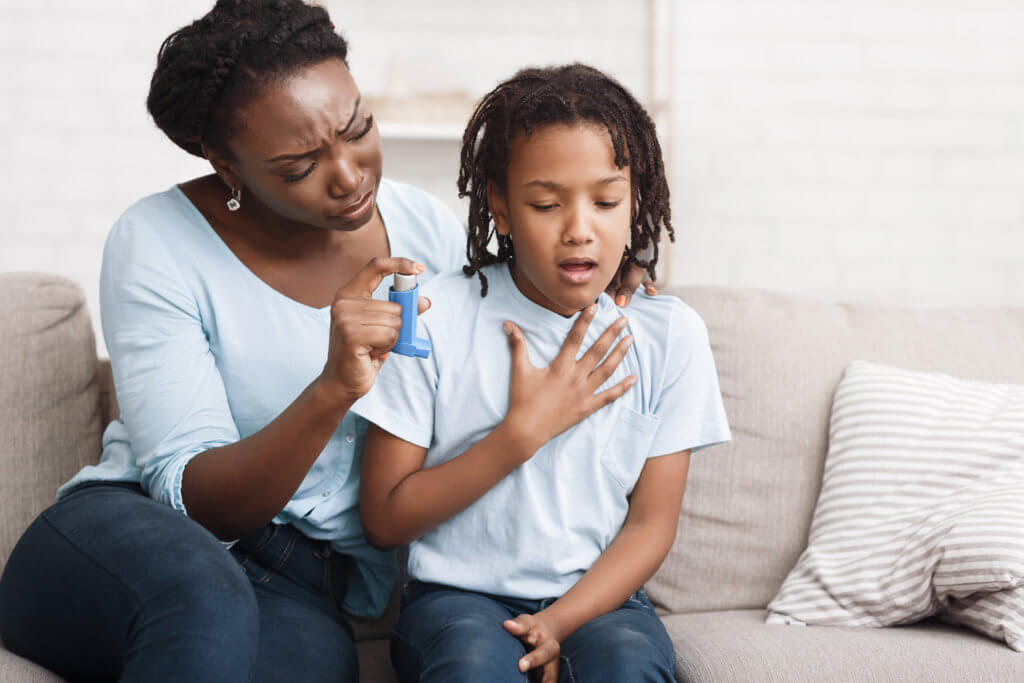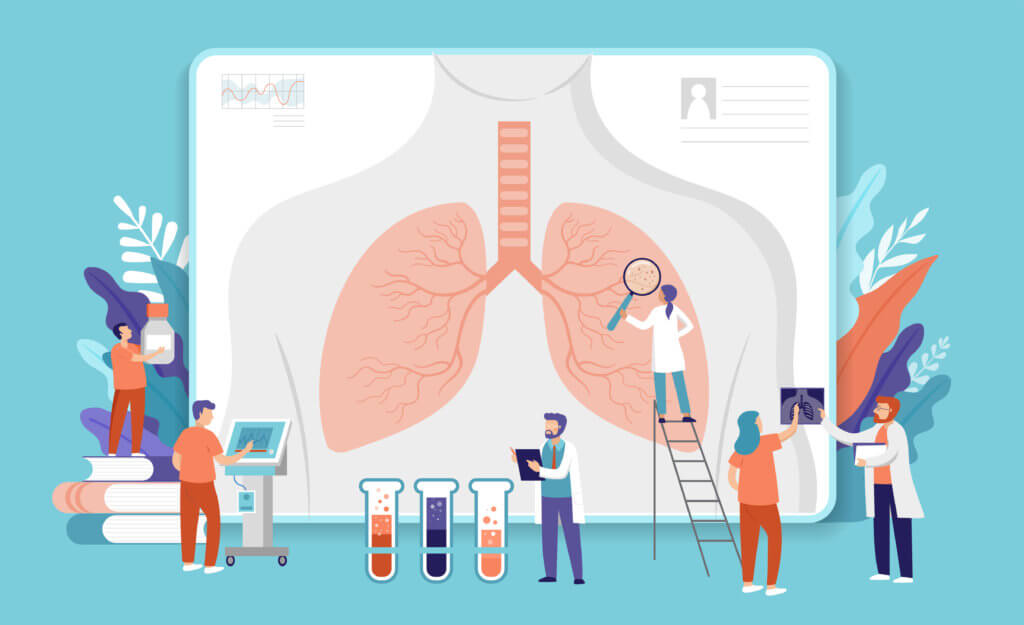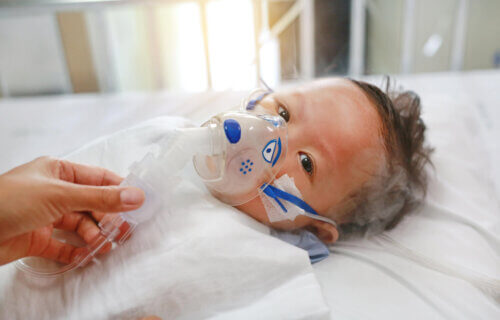Respiratory syncytial virus (RSV) is an extremely common virus that infects the lungs and breathing passages. In healthy people, symptoms of RSV infection are usually mild, like the common cold, and resolve in about a week. RSV can, however, cause severe illness or death in vulnerable individuals of any age.
Usually, RSV illness is seasonal, with most cases in the late fall, winter, and early spring. With mask-wearing, isolation, and physical distancing for COVID-19 management, there were fewer cases of RSV in 2020. Once safety measures relaxed with the arrival of COVID-19 vaccines, however, a rise in RSV cases began in spring 2021 and surged that summer. RSV is not adhering to its previous annual pattern of case occurrences.
Here’s what you should know and what’s just a myth about this illness:
1. More cases of RSV occur in children under 2 than any other age group
Fact: Ninety percent of children get an RSV infection by the time they are two years-old. Usually, RSV will cause a mild, cold-like illness. It can, however, also cause severe illness. One to two out of every 100 children younger than six months of age with RSV infection may need hospitalization. Hospitalized children may require oxygen, IV fluids (if they are not eating and drinking), and/or a machine (ventilator) to help with breathing. Most improve quickly with this supportive care.
2. Asthma is a long-term complication in infants with severe RSV infection before their first birthday
Fiction: Asthma is not a complication of RSV infection, but RSV can cause bronchiolitis. Bronchiolitis causes the small breathing tubes of the lungs (bronchioles) to swell, blocking airflow through the lungs. Infants develop bronchiolitis more often than older children because their airways are smaller and more easily blocked.
Bronchiolitis often starts with the signs you expect from a cold, such as a runny nose, mild cough, and fever. In one or two days, the cough may get worse, and an infant will begin to breathe faster. If your child shows signs of trouble breathing call their doctor. The signs of trouble breathing include:
- Widening nostrils and squeezing the muscles under the rib cage, trying to get more air in and out of the lungs.
- Grunting and tightening their stomach muscles.
- Making a high-pitched whistling sound, called wheezing, when they are trying to breathe out.
- Trouble drinking because they may have trouble sucking and swallowing.
- If it gets very hard for your baby to breathe, you may notice a bluish tint around their lips and fingertips, meaning they are not getting enough oxygen.
Although asthma is not a complication of RSV, severe RSV can predict which children may be prone to develop asthma in the future.

3. A child whose mother smoked during pregnancy is at greater risk for RSV infection and a more severe case
Fact: Some conditions cause a child to be at greater risk for RSV infection. These include:
- Mother smoking during pregnancy
- Premature birth, especially before 29 weeks gestation
- Chronic lung disease of prematurity
- Low birth weight infants
- Some heart defects present at birth
- Weak immune system due to other illnesses or their treatment
- Having siblings
- Exposure to secondhand smoke in their home
- History of eczema
- History of allergies
- Exposed to children in a childcare setting
- Crowded living conditions
4. There is a vaccine for the prevention of RSV in children
Fiction: Researchers are working to develop an RSV vaccine for infants and children.
Palivizumab (pah-lih-VIH-zu-mahb) is available to prevent severe RSV illness in infants and children at high risk for severe disease. These include infants born prematurely, those with some heart diseases, some heart defects present at birth, or chronic lung disease. The drug can help prevent severe RSV disease, but it cannot cure or treat children already suffering from severe RSV disease, and it cannot prevent infection with RSV.
If your child is at high risk for severe RSV disease, talk to your healthcare provider to see if palivizumab can be used as a preventive measure. It contains antibodies against RSV. When used for prevention, it is administered by injection, once monthly during the RSV season. RSV is not closely adhering to its pre-pandemic seasonal pattern, however, making the use of palivizumab “interseasonal.”
5. A person who has had RSV has long-term immunity
Fiction: RSV is a widespread cause of illness in humans, partly because it lacks long-term immunity after infection, making reinfection frequent. It infects virtually all children by their second birthday and frequently reinfects older children and adults.
6. Adults 55 years and older are at increased risk for severe RSV infection
Fiction: RSV infections can be dangerous for certain adults. Adults at highest risk for severe RSV infection include:
- Older adults, especially those 65 years and older
- Adults with chronic heart or lung disease
- Adults with weakened immune systems
Each year, between 60,000 and 160,000 older adults in the United States are hospitalized due to RSV, and there are about 6,000 to 10,000 deaths due to RSV infection. When an older adult gets RSV infection, they typically have mild cold-like symptoms including runny nose, sore throat, cough, and headache. In vulnerable adults, however, RSV can lead to severe conditions such as:
- Pneumonia (infection of the lungs)
- More severe symptoms for people with asthma
- More severe symptoms for people with chronic obstructive pulmonary disease (COPD)
- Congestive heart failure
Older adults are at greater risk than young adults for severe infection and serious complications from RSV because the immune system weakens with increasing age.

7. There is a vaccine for adults at higher risk for severe RSV infection
Fact: The U.S. Food and Drug Administration approved Arexvy in May 2023, the first respiratory syncytial virus (RSV) vaccine available in the United States. Arexvy is intended for the prevention of RSV-related lower respiratory tract disease caused by RSV in everyone 60 years of age and older.
“Older adults, in particular those with underlying health conditions, such as heart or lung disease or weakened immune systems, are at high risk for severe disease caused by RSV,” says Peter Marks, M.D., Ph.D., director of the FDA’s Center for Biologics Evaluation and Research, in a statement. “Today’s approval of the first RSV vaccine is an important public health achievement to prevent a disease which can be life-threatening and reflects the FDA’s continued commitment to facilitating the development of safe and effective vaccines for use in the United States.”
In one study, about 12,500 participants received Arexvy and 12,500 participants received a placebo. The vaccine reduced the risk of developing severe RSV by 82.6 percent and reduced the risk of developing severe RSV-associated lower respiratory tract disease by 94.1 percent.
8. Oxygen should be routinely administered to older hospitalized adults
Fiction: The mainstay of treatment for patients with RSV is supportive care. Oxygen is recommended only for hypoxic patients – meaning they have insufficient oxygen in the bloodstream to supply the entire body.
Supportive care consists of nasal suction and lubrication to relieve nasal congestion, acetaminophen for fever, hydration, and oxygen for patients experiencing hypoxia.
9. Respiratory droplets spread RSV from an infected person
Fact: RSV can spread when:
- An infected person coughs or sneezes.
- You get virus droplets in your eyes, nose, or mouth.
- You have direct contact with the virus, like kissing the face of a child with RSV.
- You touch a surface that has the virus on it, like a doorknob, and then touch your face before washing your hands.
People infected with RSV are usually contagious for three to eight days and may become contagious a day or two before they start showing signs of illness. Some infants, and people with weakened immune systems, can continue to spread the virus even after they stop showing symptoms, for as long as four weeks. Children are often exposed to and infected with RSV outside the home, such as in school or childcare centers. They can then transmit the virus to other members of the family.
10. RSV can survive for many hours on hard surfaces such as tables and doorknobs
Fact: There are steps you can take to help prevent the spread of RSV. Specifically, if you have cold-like symptoms you should:
- Cover your coughs and sneezes with a tissue or upper shirt sleeve, not your hands.
- Wash your hands using soap and water for 20 seconds.
- Avoid close contact, such as kissing, shaking hands, sharing cups, and eating utensils with others.
- Keep hard surfaces such as doorknobs and mobile devices clean and disinfect if possible.
Ideally, people with cold-like symptoms should avoid children at elevated risk for severe RSV disease. If this is not possible, they should carefully follow these prevention steps and wash their hands before interacting with these children. They should also refrain from kissing high-risk children while they have cold-like symptoms.
In addition to individual research papers cited in the text, information for this article was obtained from the Centers for Disease Control and Prevention (CDC), the National Institutes of Health (NIH), and the American Academy of Pediatrics (AAP).

